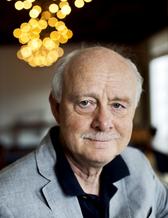An archaeologist at the University of Gothenburg will lead and coordinate an international research project that has been awarded EUR 10 million in funding from the European Research Council. The team is made up of top researchers in a number of disciplines, who together aim to reveal the changes that lay behind human migrations 8,000 years ago.
This is a research project that defies the boundaries of archaeology, genetics and mathematical modelling

Photo: Johan Wingborg
Which came first: Climate changes or social and economic changes? How did cultural and genetic changes influence each other? And what caused people to migrate?
"These are some of the big questions that the project will answer," says Kristian Kristiansen, Professor in Archaeology at the University of Gothenburg, who will lead and coordinate the entire research project.
By combining novel modelling approaches with archaeology and large quantities of data and analyses - including everything from prehistoric genetic material to climate data - the research team aims to discover and explain the key processes behind the genetic and cultural diversity in Europe. The researchers will investigate the period from the first farmers around 6,000 years BCE, to the end of the Bronze Age around 500 years BCE.
The project has been awarded an ERC Synergy Grant by the European Research Council (ERC) and it is the first time ever a researcher from the University of Gothenburg has been awarded this highly prestigious grant.
Top-tier researchers
The ERC's Synergy projects represent the absolute top-tier of European research projects and target small groups of very prominent researchers who want to collaborate on a joint research project. As the name suggests, these research projects bring together leading researchers from different fields who join forces to achieve new, innovative results that none of them could have achieved alone.
The project entitled "From correlations to explanations: towards a new European prehistory" will be led and coordinated by Bronze Age specialist Kristian Kristiansen, Professor in Archaeology, and archaeologist Karl Göran Sjögren from the University of Gothenburg. In addition to other archaeologists from the University of Gothenburg, the project also includes strontium isotope specialists from the National Museum in Copenhagen, geneticists and archaeologists from University College London and geneticists from the Lundbeck Foundation GeoGenetics Centre at the University of Copenhagen.
"We will combine results from hundreds of human prehistoric genomes with analyses of environmental and climate data, archaeological data and analyses of strontium isotopes showing population mobility," says Professor Kristian Kristiansen at the University of Gothenburg.
"By looking at the patterns of strontium isotopes in human bones, you can trace the origins of specific individuals. The element strontium is similar to calcium and is thus easily taken up by the skeleton. But the pattern of strontium isotopes varies greatly from site to site, and thus an analysis of strontium isotopes can provide answers to the question of where a particular person came from."
Many small-scale changes generate large-scale patterns
"The project aims to reveal how genetic and cultural changes and environmental changes influenced each other during some of the big historical changes in the studied period. We will investigate how many small-scale changes generate large-scale patterns of genetic and cultural change, and explore how they interact and influence each other," says Kristian Kristiansen.
The six-year research project will combine large quantities of data and methods that will be used to discern larger patterns.
"We will use novel modelling approaches that allow us to move from correlations to explanations for how changes have been shaped by the dynamic interaction between cultural innovation, migration, genetic admixture, population growth and collapse, dietary changes, biological adaptation, social structure, and the emergence of new diseases."
Databases and models
The overarching goal of the project has been broken down into specific milestones, which have been translated into four work packages. The work packages are about creating a C14 database, cultural and subsistence (including isotope) data, ancient genomes, eDNA sites, fossil pollen datasets and strontium samples for example, as well as analysing environmental DNA and building various models.
The results will enable researchers to determine the impact that population mobility had on the European landscape - during the studied period and at different levels: continental, regional and local.
"This is a research project that defies the boundaries of archaeology, genetics and mathematical modelling. By identifying prehistoric patterns in interactions between human biology, social and economic organisation, and demographics, we will be able to compare the results with anthropological and historical models of these kinds of processes from more recent times. This will enable us to acquire a more comprehensive understanding of the nature of migration, integration and cultural change - then and now," says Kristian Kristiansen.






